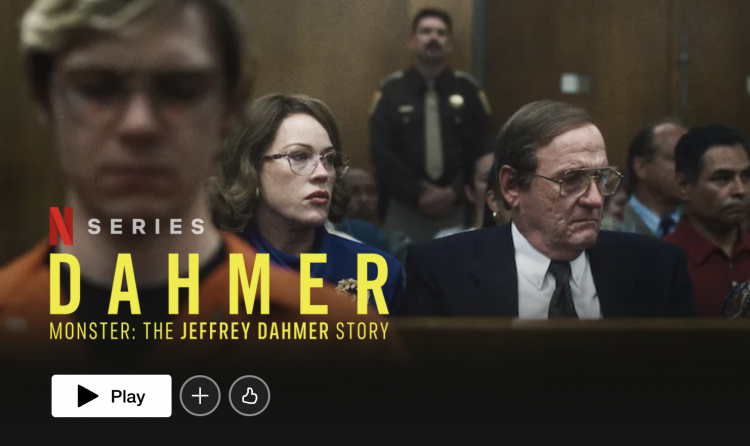Our Media and the Spectacle of Black Trauma

There are a few things that shock marginalized people, especially Black people and even more so, Black women and Black LGBT people today. Enter Netflix’s, Monster:The Jeffrey Dahmer Story. Despite only launching on the platform in September, the series has already drawn a record breaking viewership. The re-imagining of the infamous Dahmer, known colloquially as the ‘Milwaukee cannibal’, ‘is another installment that ‘mainstreams’ the tragedies of the 17 victims of the serial killer’s bout of terrorism in Wisconsin in the 1980s.
The obsession with the show, reportedly watched by 56 million households, speaks volumes about our society’s consumption of sensationalist media. Since his conviction, approximately a dozen pieces of large-scale, mainstream media projects have been made about Dahmer, with three being produced by Netflix itself.
There is something that remains viscerally uncomfortable about the way the public, specifically non-marginalized and non-Black communities interact with the harrowing stories of Black misfortune, tragedy, and sadness. If we compare how the documentary was received with the paralleled stories of similar subject matter, you’ll clearly see the level of erasure of marginalized stories and how it’s rooted in ‘racialized-sexist-classism’ that our politics has tethered itself to throughout history.
It’s a tale as old as time. Dr. Kimberlé Crenshaw touched on this phenomena in her Black Feminist theory on the discrimination of Black women in the U.S, arguing that race discrimination favors the sex and class privileged, while sex discrimination favors the race and class privileged. Similarly, the Dahmer documentary suffers from social erasure because discussions on Blackness center cisgender heterosexual Black men, while LGBT portrayals prioritize white individuals within the community. There is little acknowledgment of those who suffer from the intersections of racialized, patriarchal, or sexualized experiences of oppression.
Image Credit: Wikimedia Commons/SpayntonExpository media about the tragedies of Black people isn’t novel. It’s what the world wants and dare I say, sometimes it is needed. It’s a stinging capitalist truth that tragedy sells. The ‘need’ boils down to a question of valuing marginalized histories to reform and re-imagine our societies for the better. Factoring in motives of personal gain, sensationalism, and racial discrimination gives us a very fine line to walk along, a line that is often crossed when it comes to telling historically Black and Black intersectional stories.
I enjoy true-crime as much as the next person, but it’s time to interrogate the grander purpose behind pursuing and rehashing a story so infamous and gory for public consumption. Last month Netflix also generated considerable negative press following the release of Blonde, a biopic on famed starlet Marilyn Monroe. In the same week, the service faced palpable yet considerably muted scrutiny around The Jeffrey Dahmer Story.
The superficial, money-grab approach of Netflix’s Dahmer story merits its own criticism. But, the entitlement of non-Black audiences, specifically white women, and the rightfully negative reception of Blonde coupled with a flippant reaction towards the harrowing tales of Dahmer’s victims is even more telling. This isn’t surprising to marginalized people, especially women of color. White womanhood is no stranger to the conceited and performative act of one-sided vitriol. Even when challenging the grossly executed sensationalism of female pain in media like Blonde, attention is given to the Marilyns, the Amys, and the Britneys, and seldom towards the Whitneys, Billies, or Janets.
The situation boils down to entitlement to Black stories, trauma, and identities. The society we live in has an undying claim to the Black identity in profiting and demanding Black trauma be exploited as a form of entertainment. The insatiable demeanor with which viewers, specifically white-women, demanded more gore from the Dahmer documentary is concerning. One Netflix user remarked that they “binged the whole show unphased.”, even taking it a step further by watching “his trial and every interview of him that exists.” Another took to the platform to say she was “bummed [Netflix] didn’t show the actual morbid parts”.
Image Credit: UnsplashThis tone-deaf reaction is bound to happen when a marginalized few fail to recognize the importance of intersectional stories. It’s a by-product of believing that the path to social justice is centering your story in every space and denying other groups the agency over their own tragedies. If we seek justice as an end goal while telling these stories, it is incumbent to listen and center stories that haven’t been given the cultural center-stage before. What Netflix did, or claims to be doing with yet another Jeffrey Dahmer series, couldn’t be further from that. It’s a half-baked attempt to center intersectional narratives. The victims lie at the marginal intersection of race and sexual identity, but the overplayed villain story is just that — overplayed.
Victimized families have long spoken out against the exploitation of pain for profit. Rita Isbell, a character portrayed in the Netflix series and real-life sister to Errol Lindsey, one of Dahmer’s victims, “felt like [she was] reliving it all over again” after watching scenes based directly on her impact statement. Shirley Hughes, whose son also fell victim to Dahmer, failed to understand the premise behind retraumatizing their families yet again in the name of ‘public awareness’.
Whilst the families of Dahmer’s victims expressed disdain at the gory retelling of profoundly personal tragedies of Black and Brown people of color, none have received even a portion of the financial gain the series generated.
We find ourselves in a world where a media giant like Netflix can lay off a better part of 150 employees targeted towards curating diverse content, and beleaguer the families of marginalized communities with real tales of harrowing systemic oppression at the same time. Is Netflix attempting to rectify its failures of diversity by telling the story of a predatory, racist, cannibal? Is our society savage and unbecoming enough to consume it insatiably?









